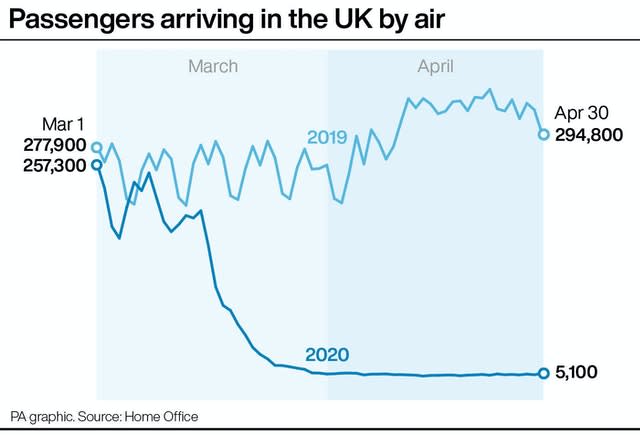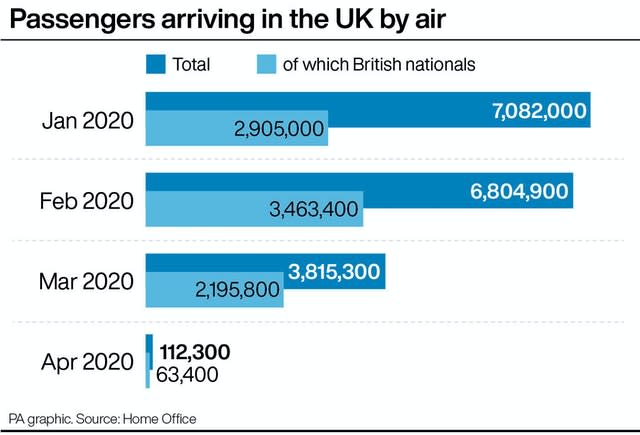UK-bound air passenger numbers plummet by 99% during coronavirus
The number of passengers arriving in the UK by air fell “sharply” since the start of the coronavirus pandemic from around 7.1 million in January to 112,300 in April.
The figure for last month is 99% lower than the number of air passengers who came into the country in April 2019, according to the Advance Passenger Information (API) data published by the Home Office.
A report published on Thursday said the majority (58%) of arrivals since the lockdown was announced on March 23 were British nationals coming back to the UK.
The remaining 42% “will include foreign nationals who are UK residents returning to the UK, dependants of UK residents, and other non-British nationals”.
While the reduction in air travel was “most marked”, over this period the number of passengers arriving by sea was 97% fewer and by rail was 98% fewer than the same time the previous year, according to the report.

It said: “The Covid-19 pandemic has had a significant impact on the UK immigration system, both in terms of restricting migrant movements to and from the UK and the impact on operational capacity.”
According to the figures, 7,082,000 people arrived by air in January, of which 41% (2,905,000) were British nationals.
This fell to 6,804,900 in February, with 3,463,400 (51%) being British nationals.
In March there were 3,815,300 arrivals by air, including 2,195,800 British nationals (58%), before dropping to 112,300 in April (63,400 British nationals, 56%).
The daily figures for the first four months of the year show a peak of 315,900 on January 5, less than half of which were British nationals (142,300), before plummeting to a low of 1,900 on April 14 (1,000 of which were British nationals).
The number of arrivals by air a year earlier, on April 14 2019, was 336,100.
But the data is classed as provisional and figures are not exact because they are rounded to the nearest 100 passengers.
The report said the figures, derived from API and Border and Immigration Transaction Data (BITD), “are not designed for statistical purposes and there are known issues in producing estimates of arrivals from these sources”.

It added: “Neither data source provides an exact count of the number of arrivals.
“However, the data are being included here to provide an indication of the key trends in passenger arrivals in response to the Covid-19 pandemic and associated lockdown measures.”
The report does not included figures for all those arriving by sea or rail, by private aircraft or from the Common Travel Area (CTA) between the UK, Ireland, Isle of Man and Channel Islands.
The number of applications and decisions being made on “all types” of visas has also fallen since the start of the pandemic after application centres were closed by the end of March.
“Since then, very few applications or decisions have been recorded, although some case working continues to take place”, the report said.
There were around 129,000 visa applications submitted in March, less than half the number made in the same month last year (281,000).
The number of applications from Chinese nationals fell from the start of the year. In January and February, this accounted for 8% of all visa applications, down from 18% over the same period in 2019.
There was a “significant” drop in applications from all other nationalities from March, with only around 250 applications recorded in April.
There were 145,000 decisions made on visa applications in March – 42% fewer than a year earlier (248,000). Less than 100 decisions were made in April.
The number of visa extensions being granted – so someone is permitted to have leave to remain in the UK for longer – also fell with 77% fewer in April compared to the same month last year.
Between January and March, there were around 60,000 extensions granted.
The decrease came while staff were set up to carry on working from home, the report said. The data does not include visa extensions being granted for foreign NHS and care workers.

 Yahoo News
Yahoo News 